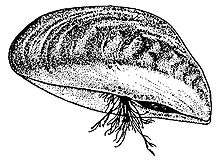Byssus


A byssus /ˈbɪsəs/ is a bundle of filaments secreted by many species of bivalve mollusc, that function to attach the mollusc to a solid surface. Species from several families of clams have a byssus, including the pen shells, the true mussels and the false mussels: the Pinnidae, the Mytilidae and the Dreissenidae.
Byssus cloth is a rare fabric, also known as sea silk, that is made using the byssus of pen shells as the fiber source.
| Look up Byssus in Wiktionary, the free dictionary. |
The filaments
Byssus filaments are created by certain kinds of marine and freshwater bivalve molluscs, which use the byssus to attach themselves to rocks, substrates, or seabeds. In edible mussels, the inedible byssus is commonly known as the "beard", and is removed before cooking.
Byssus often refers to the long, fine, silky threads secreted by the large Mediterranean pen shell, Pinna nobilis. The byssus threads from this Pinna species can be up to 6 cm in length and have historically been made into cloth.
Many species of mussels secrete byssus threads to anchor themselves to surfaces, with Families including the Arcidae, Mytilidae, Anomiidae, Pinnidae, Pectinidae, Dreissenidae, and Unionidae.
When a mussel's foot encounters a crevice, it creates a vacuum chamber by forcing out the air and arching up, similar to a plumber's plunger unclogging a drain. The byssus, which is made of keratin, quinone-tanned proteins (polyphenolic proteins), and other proteins, is spewed into this chamber in liquid form, and bubbles into a sticky foam. By curling its foot into a tube and pumping the foam, the mussel produces sticky threads about the size of a human hair. The mussel then varnishes the threads with another protein, resulting in an adhesive.
Byssus is a remarkable adhesive, one that is neither degraded nor deformed by water as synthetic adhesives are. This property has spurred genetic engineers to insert mussel DNA into yeast cells for translating the genes into the appropriate proteins.[1]
See also
Footnotes
- ↑ Robert L. Strausberg; et al. (31 December 1989). "Development of a Microbial System for Production of Mussel Adhesive Protein". doi:10.1021/bk-1989-0385.ch032.
References
- Ecsedy, Hilda 1975. "Böz – An Exotic Cloth in the Chinese Imperial Court." Hilda Ecsedy. Altorientalische Forschungen 3: pp. 145–153.
- Starr, Cecie and Taggart, Ralph. Biology: The Unity and Diversity of Life. Belmont, CA: Thomson Learning, Inc., 2004.
- Hill, John E. (2009) Through the Jade Gate to Rome: A Study of the Silk Routes during the Later Han Dynasty, 1st to 2nd centuries CE. BookSurge, Charleston, South Carolina. ISBN 978-1-4392-2134-1. See Section 12 plus "Appendix B – Sea Silk."
- Hill, John E. 2004. The Peoples of the West. A draft annotated translation of the 3rd century Weilüe – see Section 12 of the text and Appendix D.
- McKinley, Daniel L. 1988. "Pinna and Her Silken Beard: A Foray Into Historical Misappropriations". Ars Textrina: A Journal of Textiles and Costumes, Vol. Twenty-nine, June 1998, Winnipeg, Manitoba, Canada. pp. 9–223.
- Maeder, Felicitas 2002. "The project Sea-silk — Rediscovering an Ancient Textile Material." Archaeological Textiles Newsletter, Number 35, Autumn 2002, pp. 8–11.
- Maeder, Felicitas, Hänggi, Ambros and Wunderlin, Dominik, Eds. 2004. Bisso marino: Fili d’oro dal fondo del mare — Muschelseide: Goldene Fäden vom Meeresgrund. Naturhistoriches Museum and Museum der Kulturen, Basel, Switzerland. (In Italian and German).
- Turner, Ruth D. and Rosewater, Joseph 1958. "The Family Pinnidae in the Western Atlantic" Johnsonia, Vol. 3 No. 38, 28 June 1958, pp. 285–326.
- Adamo Fabbroni, Del Bombice e del Bisso degli antichi, Stamperia del Costantini, Perugia, 1783
- Pietro Lazzarini, Bisso e porpora: il b. Angelo Orsucci, domenicano lucchese (martire nel Giappone), Società Editrice Internazionale, Torino, 1950
- Daniel McKinley, Pinna and her silken beard: a foray into historical misappropriations, in: Ars Textrina – A Journal of Textiles and Costume, Volume 29, Giugno 1998, Charles Babbage Research Centre for the Editorial Board, Winnipeg, 1998
- Evangelina Campi, La seta del mare: il bisso: storia, cultura, prospettive, Scorpione Editrice, Taranto, 2004, ISBN 978-8880991380
- Felicitas Maeder, Ambros Hänggi, Dominik Wunderlin, Bisso marino. Fili d’oro dal fondo del mare – Muschelseide. Goldene Fäden vom Meeresgrund, Catalogo della Mostra (Basel, 19 marzo-27 giugno 2004), 5 Continents Editions, Milano, 2004, ISBN 978-8874391141
- Susanna Lavazza, Dal buio alla luce, il bisso marino e Chiara Vigo, Cartabianca Publishing, Trevignano Romano, 2012, ISBN 978-8888805016
- Susanna Lavazza, Chiara Vigo - L'ultimo Maestro di bisso, Carlo Delfino editore, Sassari, 2014, ISBN 978-8871387857
- Rossana Cingolani, Chiara Vigo, l'ultimo Maestro di Bisso Marino, Carlo Delfino editore, Sassari, 2014
- Eduardo Delehaye, Il bisso una fibra misteriosa fra storia e letteratura, Carlo Delfino editore, Sassari, 2016, ISBN 978-8871389042